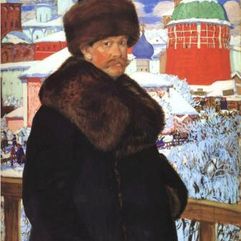

Boris Kustodiev
1878 - 1927
Boris Mikhaylovich Kustodiev was a Russian and later Soviet painter and stage designer.
Career
The Russian Revolution of 1905, which shook the foundations of society, evoked a vivid response in the artist's soul. He contributed to the satirical journals Vampir (Vampire), Zhupel (Bugbear) and Adskaya Pochta (Hell's Mail). At that time, he first met the artists of Mir Iskusstva (World of Art), the group of innovative Russian artists. He joined their association in 1910 and subsequently took part in all their exhibitions.
In 1905, Kustodiev first turned to book illustrating, a genre in which he worked throughout his entire life. He illustrated many works of classical Russian literature, including Nikolai Gogol's Dead Souls, The Carriage, and The Overcoat; Mikhail Lermontov's The Lay of Tsar Ivan Vasilyevich, His Young Oprichnik and the Stouthearted Merchant Kalashnikov; and Leo Tolstoy's How the Devil Stole the Peasants Hunk of Bread and The Candle.
In 1909, he was elected into Imperial Academy of Arts. He continued to work intensively, but a grave illness-tuberculosis of the spine-required urgent attention. On the advice of his doctors he went to Switzerland, where he spent a year undergoing treatment in a private clinic. He pined for his distant homeland, and Russian themes continued to provide the basic material for the works he painted during that year. In 1918, he painted The Merchant's Wife, which became the most famous of his paintings.
In 1916, he became paraplegic. "Now my whole world is my room", he wrote. His ability to remain joyful and lively despite his paralysis amazed others. His colourful paintings and joyful genre pieces do not reveal his physical suffering, and on the contrary give the impression of a carefree and cheerful life.
His Pancake Tuesday/Maslenitsa (1916) and Fontanka (1916) are all painted from his memories. He meticulously restores his own childhood in the busy city on the Volga banks.
In the first years after the Russian Revolution of 1917 the artist worked with great inspiration in various fields. Contemporary themes became the basis for his work, being embodied in drawings for calendars and book covers, and in illustrations and sketches of street decorations, as well as some portraits (Portrait of Countess Grabowska).
His covers for the journals The Red Cornfield and Red Panorama attracted attention because of their vividness and the sharpness of their subject matter. Kustodiev also worked in lithography, illustrating works by Nekrasov. His illustrations for Leskov's stories The Darner and Lady Macbeth of the Mtsensk District were landmarks in the history of Russian book designing, so well did they correspond to the literary images.
Stage design
The artist was also interested in designing stage scenery. He first started work in the theatre in 1911, when he designed the sets for Alexander Ostrovsky's An Ardent Heart. Such was his success that further orders came pouring in. In 1913, he designed the sets and costumes for The Death of Pazukhin at the Moscow Art Theatre.
His talent in this sphere was especially apparent in his work for Ostrovsky's plays; It's a Family Affair, A Stroke of Luck, Wolves and Sheep, and The Storm. The milieu of Ostrovsky's plays-provincial life and the world of the merchant class-was close to Kustodiev's own genre paintings, and he worked easily and quickly on the stage sets.
In 1923, Kustodiev joined the Association of Artists of Revolutionary Russia. He continued to paint, make engravings, illustrate books, and design for the theater up until his death of tuberculosis on 28 May 1927, in Leningrad.
Text courtesy of Wikipedia, 2024

















